The John Hancock Premium Dividend Fund (NYSE:PDT) is a closed-end fund, or CEF, that income-seeking investors can use as a method of earning a high level of income from their assets. The fund manages to do pretty well here, as its 8.05% yield compares quite well with many of its peers:
|
Fund Name |
Morningstar Classification |
Current Yield |
|
John Hancock Premium Dividend Fund |
Fixed Income-Taxable-Preferreds |
8.05% |
|
Cohen & Steers Select Preferred and Income Fund (PSF) |
Fixed Income-Taxable-Preferreds |
7.67% |
|
Flaherty & Crumrine Dynamic Preferred and Income Fund (DFP) |
Fixed Income-Taxable-Preferreds |
6.78% |
|
Nuveen Preferred & Income Opportunities Fund (JPC) |
Fixed Income-Taxable-Preferreds |
10.32% |
|
First Trust Intermediate Duration Preferred & Income Fund (FPF) |
Fixed Income-Taxable-Preferreds |
9.00% |
As we can clearly see, the John Hancock Premium Dividend Fund represents the median yield among this group of preferred stock funds. There could be some dispute as to how appropriate it is to group this fund in with other preferred stock funds, though, as the John Hancock Premium Dividend Fund invests in both common and preferred equity. As everyone reading this is no doubt well aware, common equity has significantly lower yields than preferred equity, so this can be expected to drag down the yield of the fund relative to other funds that invest solely in preferred stock. Curiously, though, this fund still manages to beat a few pure-play preferred stock funds. This arguably shows the fund’s quality compared to some other funds on this list. Another indicator of the fund’s quality is the fact that it delivered better share price appreciation than either the Cohen & Steers Select Preferred and Income Fund or the Flaherty & Crumrine Dynamic Preferred and Income Fund over the past year:
Seeking Alpha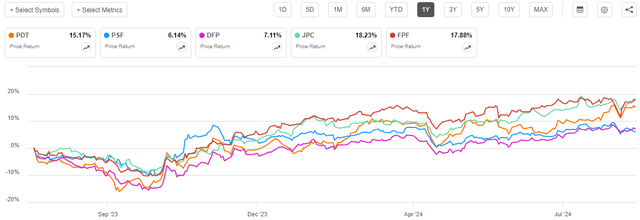
There arguably appears to be a desire for yield here, as the highest-yielding funds delivered the best share price appreciation and vice versa. The fact that the John Hancock Premium Dividend Fund outperformed its two lower-yielding peers and still manages to deliver a higher yield is further testament to the fact that it possesses many of the qualities that income-seeking investors desire.
As regular readers might remember, we previously discussed the John Hancock Premium Dividend Fund back in February of this year. The equity market since that time has been fairly strong, but bond markets have been weak as the market has been adjusting to the fact that inflation continues to be a problem and that the Federal Reserve will not be cutting interest rates as rapidly as some observers had desired. Basically, fixed-income prices at the start of this year were far too high based on where rates are likely to be at the end of 2024, so bond prices had to adjust to this new reality. Ordinarily, we would expect preferred stock prices to follow bonds lower, but they have held up much better than most bonds. Interestingly, though, for some reason, investors have been bidding up the price of preferred stock closed-end funds despite a “higher for longer” environment and the disappointing performance of most preferred stock issues. As such, we might expect the John Hancock Premium Dividend Fund to have delivered fairly attractive share price appreciation.
This is indeed the case, as shares of the John Hancock Premium Dividend Fund have risen by 11.31% since my previous article was published. This is not only better than the ICE Exchange-Listed Preferred & Hybrid Securities Index (PFF) but it is actually better than the S&P 500 Index (SP500):
Seeking Alpha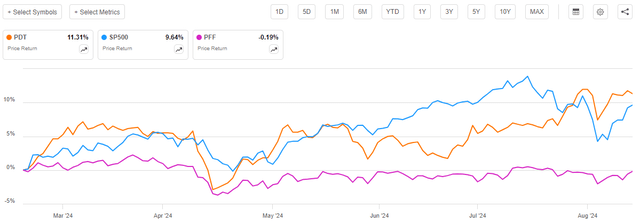
This is surprising, as we would not ordinarily expect that a preferred stock fund would outperform large-cap common equities. The John Hancock Premium Dividend Fund does contain some common equity, but it is not nearly enough to allow the fund’s portfolio to match the equity index. As preferred stocks have actually declined over the period, we would expect the presence of those securities in the fund’s portfolio to lag on its performance. We should therefore pay very close attention to this fund’s valuation, as the market may have overpriced it relative to the fund’s actual portfolio.
As I noted in a recent article, investors in closed-end funds such as this one usually fare a lot better than the share price performance indicates:
A simple look at a closed-end fund’s share price performance does not necessarily provide an accurate picture of how investors in the fund did during a given period. This is because these funds tend to pay out all of their net investment profits to the shareholders, rather than relying on the capital appreciation of their share price to provide a return. This is the reason why the yields of these funds tend to be much higher than the yield of index funds or most other market assets.
The distributions provide a very real return to the fund’s shareholders that is not reflected in the share price. When we take the distributions that this fund and the indices paid out during the period, we get this alternative chart:
Seeking Alpha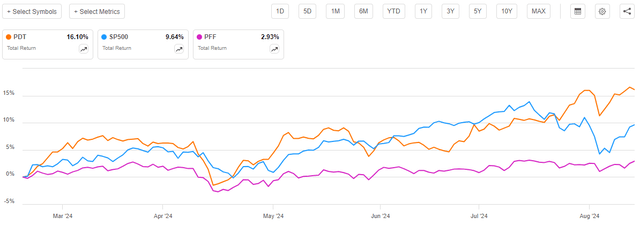
As is clearly shown here, investors in the John Hancock Premium Dividend Fund ended up earning a return that not only beat the preferred stock index, but also ended up beating the S&P 500 Index over the period. This certainly speaks well about this fund, and it will almost certainly be attractive to most potential investors, regardless of their goals. However, as mentioned previously, there is a risk that the market has gotten too enthusiastic about this fund and bid up its shares to unjustifiable levels. If that is the case, we might expect that the fund will surrender some of its recent gains at some point.
As roughly six months have passed since we last discussed the John Hancock Premium Dividend Fund, we can expect that several things have changed. In particular, the fund has released an updated financial report that will be helpful for our purposes today. Let us take a look at the events that have occurred over the past six months and see if we need to update our thesis regarding this fund.
About The Fund
According to the fund’s website, the John Hancock Premium Dividend Fund has the primary objective of providing its investors with a high level of current income along with modest capital appreciation. This objective makes a great deal of sense for a fund that invests in both common and preferred stocks, as the website claims:
John Hancock Investments
After all, the preferred stock provides the fund with a high level of income, as do the dividend-paying common stocks. The fact that this fund invests in common stocks also provides a certain amount of capital appreciation over time, depending on what stocks the fund is invested in. The website does not provide further information about the fund’s strategy, but fortunately the fund’s prospectus provides additional information that should prove helpful in this respect. Here is what this document states:
Under normal circumstances, the Fund will invest at least 80% (plus any borrowings for investment purposes) of its net assets in dividend-paying securities. The Fund will focus on common stocks of those issuers which, in the opinion of the Advisor, have strong fundamental characteristics, large market capitalizations, favorable credit quality and current dividend yields generally higher than the currently available dividend yield quoted on the Standard & Poor’s 500 Index. The Adviser intends to manage the Fund’s portfolio to generate income qualifying for the dividends received deduction allowed corporations under Section 243(a)(1) of the Internal Revenue Code of 1986, as amended.
This description makes this fund sound very much like a common equity fund, instead of as a hybrid-preferred and common equity fund, as both the website and Morningstar suggest. After all, we note the statement in the prospectus that this fund will aim to invest in securities with yields exceeding that of the S&P 500 Index. Almost any preferred stock will typically have a yield exceeding that of the common stock index, so that is basically saying nothing about its preferred strategy. Perhaps more importantly, the description does not say anything about how the fund will divide its assets between common and preferred stock.
We can find some information about the current split between common stock and preferred stock in the fund’s most recent semi-annual report. According to this document, the fund had the following asset allocation as of April 30, 2024:
|
Asset Type |
% of Total Assets |
|
Common Stocks |
43.1% |
|
Preferred Stock |
23.4% |
|
Corporate Bonds |
32.6% |
|
Capital Preferred Securities |
0.8% |
|
Money Market |
0.1% |
This is interesting, as this clearly shows that the fund was more heavily invested in fixed-income securities than in common stocks as of April 30, 2024. The total allocation to fixed-income securities (preferred stock, capital preferred stock, and corporate bonds) was 56.8% of total assets as of that date. In addition, money market funds technically hold fixed-income securities, which brings the total up to 56.9% of total assets. However, many investors do not really consider money market assets to be fixed-income investments.
As of right now, the S&P 500 Index yields 1.26%, the investment-grade corporate bond index (LQD) yields 4.23%, and the ICE Exchange-Listed Preferred & Hybrid Securities Index yields 6.32%. Thus, given the fund’s objective of earning a high level of current income, it makes sense for it to be weighting fixed-income securities more highly than common stocks. However, this does somewhat reduce the fund’s ability to protect investors against inflation. In a recent article, I stated that inflation is likely to be a real problem going forward and suggested the use of equities as a way to protect assets against it. From that article:
One of the nice things about this fund is that it invests in equity securities, so it provides a certain amount of protection against inflation, which may be a bigger problem going forward than it has been in the past. After all, the projections for large fiscal deficits going forward are well-known, and it is difficult to see any way for these deficits to be funded apart from the creation of new currency. Historically, equities, real estate, and gold have been the best ways to preserve the purchasing power of your money against inflation.
The real problem with fixed-income securities in an inflationary environment is that the yields tend to be too low to really accomplish much. The July 2024 inflation report puts the annual inflation rate at 2.9% today. That brings down the real yields of all assets:
|
Asset/Index |
Real Yield |
|
S&P 500 Index |
-1.64% |
|
Investment-Grade Corporate Bonds |
1.42% |
|
ICE Exchange-Listed Preferred & Hybrid Securities Index |
3.42% |
There is also the issue of taxes, which for taxpayers in the top federal income bracket actually results in the investment-grade corporate bond index having a tax-equivalent yield that is below the reported consumer price index annual rate of change (a negative tax-equivalent yield). I calculated the after-tax yield for a single Florida taxpayer in the top tax bracket and got a 2.66% yield after taxes. That is less than the inflation rate. The situation would be even worse in states that levy a state income tax. In other words, right now, bond yields are too low to keep up with inflation and investors will actually lose purchasing power by buying an investment-grade corporate bond and holding it to maturity.
Thus, clearly, we can see that inflation could be a problem that we need to protect ourselves against. The John Hancock Premium Dividend Fund is not doing that nearly as well as a fund that invests solely in common equities. However, the fund does still have some equities in the portfolio, and there is also no guarantee that it will hold the bonds in its portfolio until maturity. Thus, this fund will be better than an indexed bond fund at protecting the purchasing power of your wealth against inflation, but it also might not be the best fund on the market to use for this purpose.
The quote in the prospectus clearly states that the John Hancock Premium Dividend Fund will try to focus its investments on common securities that have higher yields than the S&P 500 Index. It seems to be doing that right now. Here are the largest positions in this fund as of the time of writing:
John Hancock Investments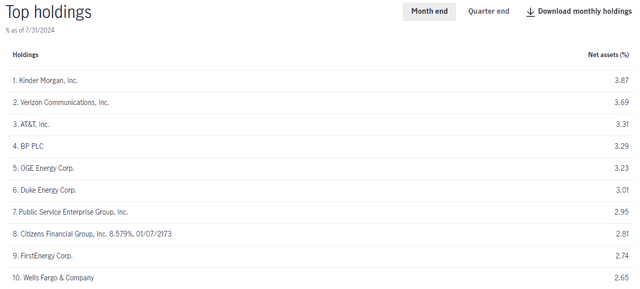
Here are the current yields of these common stocks:
|
Company |
Current Dividend Yield |
|
Kinder Morgan (KMI) |
5.49% |
|
Verizon Communications (VZ) |
6.50% |
|
AT&T (T) |
5.65% |
|
BP plc (BP) |
5.31% |
|
OGE Energy (OGE) |
4.26% |
|
Duke Energy (DUK) |
3.68% |
|
Public Service Enterprise Group (PEG) |
2.98% |
|
FirstEnergy (FE) |
4.02% |
|
Wells Fargo & Company (WFC) |
2.98% |
The Citizens Financial Group (CFG) position, which is also shown as being among the fund’s largest positions, is excluded from this second chart because that is a preferred stock issue. As was already stated, preferred stock typically has higher yields than most common stock, and this is certainly the case with that particular security.
As we can clearly see, all the common stocks found among the largest positions in the John Hancock Premium Dividend Fund have a yield that is well above the 1.26% trailing twelve-month yield of the S&P 500 Index. Thus, the fund currently appears to be in compliance with its statements about favoring these securities.
One interesting thing that has been happening recently is that high-yielding dividend stocks have been delivering very impressive performances relative to the market. For example, consider the trailing twelve-month price returns of the stocks on the fund’s largest positions list:
|
Company |
Trailing Twelve-Month Price Gain |
|
Kinder Morgan |
18.62% |
|
Verizon Communications |
22.73% |
|
AT&T |
38.26% |
|
BP plc |
-8.12% |
|
OGE Energy |
16.90% |
|
Duke Energy |
23.28% |
|
Public Service Enterprise Group |
34.85% |
|
FirstEnergy |
17.35% |
|
Wells Fargo & Company |
22.68% |
The S&P 500 Index gained 21.50% over the same period, so we can clearly see that five of these nine stocks outperformed the large-cap index over the past year. When we include the dividends paid out by these companies, investors in most of them did better than investors in the broader stock market indices. This is a nice change from the usual state of affairs over the past decade or so. As everyone reading this can likely remember, dividend-paying stocks underperformed the NASDAQ 100 (QQQ) and the S&P 500 Index over the past decade:
Seeking Alpha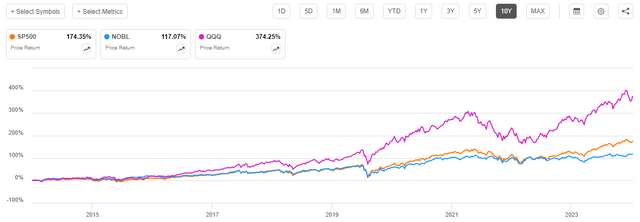
For this comparison, I opted to use the ProShares S&P 500 Dividend Aristocrats Index (NOBL) as a proxy for dividend-paying stocks. There are many others that can be used, but overall, it is not difficult to find evidence that the majority of the wealth creation that has taken place in the markets over the years since the 2008 financial crisis has been due to the major technology stocks and low-yielding growth stocks. This was almost certainly due to the ultra-low-interest rate environment that made low-yielding stocks an attractive alternative to cash. The fact that so many of the largest positions in the John Hancock Premium Dividend Fund have been outperforming recently is thus a nice change that income-oriented investors will almost certainly appreciate.
Kristie Feinberg, the President and CEO of John Hancock Investment Management, made similar observations about the market trends in the fund’s semi-annual report:
Both stocks and bonds largely posted positive gains during the six months ended April 30, 2024. Concerns that interest rates would need to stay higher for longer led to a sharp increase in bond yields and weighed heavily on investor sentiment as the period began, but rapidly dissipated following a stretch of favorable inflation readings and more dovish comments from world central bank officials. Stocks moved quickly off their previous lows in response, and the U.S. Federal Reserve added fuel to the rally in December by indicating that the central bank may in fact begin to cut rates later in 2024. Stocks surged in response but began to backtrack toward the end of the period as inflation remained elevated.
Part of the reason for the strength in dividend-paying stocks specifically is that they represent a still-attractive alternative to cash. In an environment where a good money market fund yields 5% to 5.25%, many investors would rather not take the risk of investing in a high-flying growth company with stretched a valuation and no yield. However, this same investor might be willing to purchase a stock yielding 5% or higher because it offers a worthy alternative to the same money market option. The S&P 500 Index is very heavily weighted to a handful of very low-yielding stocks, so it only makes sense that dividend-paying stocks have somewhat come back into vogue. The fund appears to be benefitting from this market trend.
There has only been one significant change to the fund’s largest holdings list since the last time that we discussed it back in February. This is that PPL Corporation (PPL) was removed from the list and replaced with Public Service Enterprise Group (PEG). This was simply the replacement of a Pennsylvania-based electric utility with a New Jersey-based electric utility, so it was not a significant change. This should not have a major impact on the fund’s portfolio performance, given that both assets are in similar sectors and share similar fundamental characteristics.
In addition, there were a few changes to the weightings of the fund’s largest assets, but this could easily be explained by one company outperforming another in the market. It is not necessarily a sign of the fund buying or selling assets to render a major change to its portfolio. Indeed, the fund only had an 8% annualized turnover during the first six months of its most recent fiscal year, so it is clearly not doing much trading.
Leverage
As is the case with most closed-end funds, the John Hancock Premium Dividend Fund employs leverage as a method of boosting the effective yield and total return of its portfolio. I explained how this works in my previous article on this fund:
Basically, the fund borrows money and then uses that borrowed money to purchase common stock and fixed-income securities. As long as the purchased securities deliver higher total returns than the interest rate that the fund has to pay on the borrowed money, the strategy works pretty well to boost the effective returns of the portfolio. As this fund is capable of borrowing money at institutional rates, which are considerably lower than retail rates, this will usually be the case. However, it is important to note that leverage is not nearly as effective at boosting returns with interest rates at 5% to 6% as it was at 0%, so the benefit that the fund receives from this strategy is going to be much less than it was a few years ago.
Unfortunately, the use of debt in this fashion is a double-edged sword. This is because leverage boosts both gains and losses. Due to this, it is important that we ensure that the fund is not using too much leverage because that would expose us to too much risk. I generally do not like to see a fund’s leverage exceed a third as a percentage of its assets for that reason.
As of the time of writing, the John Hancock Premium Dividend Fund has leveraged assets comprising 38.03% of its overall portfolio. This represents a significant improvement over the 39.27% leverage that the fund had the last time that we discussed it, which is unsurprising. After all, we have already seen that the fund’s share price increased significantly over the past six months. The fund’s net asset value has increased too, as shown in this chart:
Barchart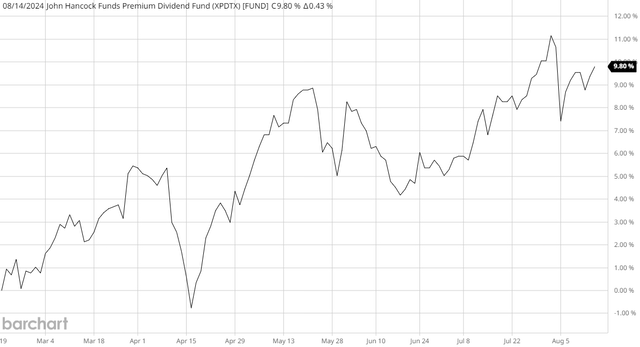
As shown in this chart, the net asset value of the John Hancock Premium Dividend Fund has increased by 9.80% since our previous discussion. As I have pointed out in various previous articles, a rising net asset value causes a fund’s leverage to go down unless it borrows more money. That was apparently the case here, as it does not appear that this fund has been increasing its borrowing activity as a response to its rising net asset value.
Despite the improvement that we have seen over the past six months, the John Hancock Premium Dividend Fund does still have a leverage ratio that is well above the one-third of assets levels that we would ordinarily prefer. This could be dangerous since that means that the fund will take heavier losses in a market correction. However, the safe amount of leverage depends heavily on the assets held by a fund, so it is best to see how the fund’s leverage compares to its peers before we render judgment:
|
Fund Name |
Leverage Ratio |
|
John Hancock Premium Dividend Fund |
38.03% |
|
Cohen & Steers Select Preferred and Income Fund |
33.78% |
|
Flaherty & Crumrine Dynamic Preferred and Income Fund |
38.40% |
|
Nuveen Preferred & Income Opportunities Fund |
38.06% |
|
First Trust Intermediate Duration Preferred & Income Fund |
33.55% |
(All figures from CEF Data)
We can see that the current leverage ratio of the John Hancock Premium Dividend Fund is not completely out of line with its peers. While this fund’s leverage ratio is larger than some, it is far from being the most leveraged fund in the sector.
The fund is probably okay right now, but as was the case before, I would still feel more comfortable if the fund were to bring down its leverage a bit more than it has already done.
Distribution Analysis
The primary objective of the John Hancock Premium Dividend Fund is to provide its investors with a high level of current income. To that end, the fund pays a monthly distribution of $0.0825 per share ($0.99 per share annually). This gives the fund a reasonably attractive 8.05% yield at the current share price.
Unfortunately, this fund has not been completely reliable regarding its distribution over the years. It has still done a better job than many others, though:
CEF Connect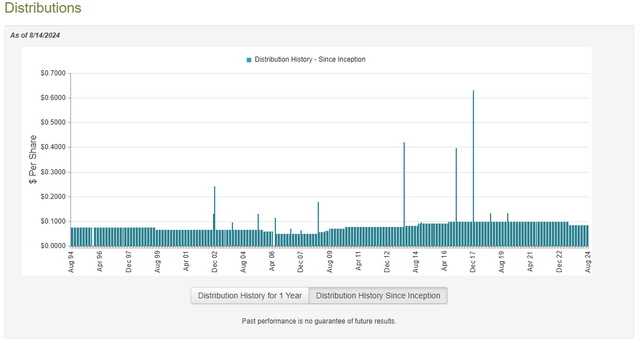
From the previous article:
As we can see here, the fund has generally been growing its distribution since 2006. It has not delivered annual increases, though. There are very few closed-end funds that have ever managed to achieve an annual distribution increase due to the volatility of asset prices. This one had one of the better track records until last year when it cut the distribution in July.
This recent cut will almost certainly reduce the fund’s appeal to those investors who are seeking a safe and consistent source of income to finance their lifestyles or even just pay their bills. The current distribution is lower than the one that the fund paid in 2015, which almost certainly further reduces its appeal considering that the prices of most goods and services were much lower in 2015 than they are today. However, most closed-end funds have had to cut their distributions over the past two years as the high level of inflation and the changing monetary environment have wreaked havoc in the markets and that has caused many of these funds to take some realized losses. It is necessary to reduce a distribution in such a situation because a fund should never unnecessarily deplete its net asset value. After all, the lower the fund’s net asset value, the higher the return that is needed to maintain a specified distribution and the harder it becomes to consistently achieve.
Let us take a look at the fund’s finances to see how easily it is covering its current distribution. As of the time of writing, the fund’s most recent financial report is the semi-annual report that corresponds to the six-month period that ended on April 30, 2024. I provided a link to this document earlier in this article. This is a newer report than the one that we had available at the time of our last discussion, so it should work well for the purpose of providing an update.
For the six-month period that ended on April 30, 2024, the John Hancock Premium Dividend Fund received $19,359,926 in dividends and $10,304,102 in interest from the assets in its portfolio. From this total, we subtract the amount of money that the fund had to pay in foreign withholding taxes to arrive at a total investment income of $29,502,987 for the six-month period. The fund paid its expenses out of this amount, which left it with $13,563,832 available for shareholders. That was not sufficient to cover the $24,346,687 that the fund paid out in shareholder distributions during the period.
Fortunately, this fund managed to make up the difference through capital gains. For the six-month period, the John Hancock Premium Dividend Fund reported net realized gains of $3,011,200, boosted by $86,086,368 net unrealized gains. Overall, the fund’s net assets increased by $78,314,713 after accounting for all inflows and outflows during the period. Thus, this fund easily covered its distribution during the most recent quarter, with quite many excess returns available for later distribution.
Investors should not need to worry too much about this fund’s ability to sustain its distribution. It looks to be in pretty good shape.
Valuation
Shares of the John Hancock Premium Dividend Fund are currently trading at a 4.11% discount to net asset value. This is reasonably in line with the 4.26% discount that the shares have had on average over the past month.
Conclusion
In conclusion, the John Hancock Premium Dividend Fund is clearly benefiting from recent market trends. In particular, dividend-paying stocks have finally started to deliver attractive returns relative to growth, and this has provided a tailwind for the assets that are held by this fund. Unfortunately, more than half of this fund is invested in fixed-income securities right now, and these are not the best things to hold in an environment in which inflation is likely to prove remarkably sticky and stubborn. The fund’s very high yield helps compensate for this somewhat, though, and it appears able to sustain it. The valuation is just okay, as it is trading discounted, but not a considerable one.
Read the full article here



